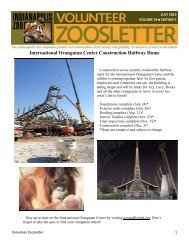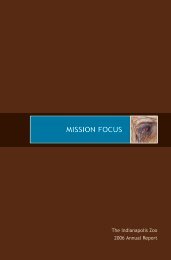Bridging The Distance - Indianapolis Zoo
Bridging The Distance - Indianapolis Zoo
Bridging The Distance - Indianapolis Zoo
You also want an ePaper? Increase the reach of your titles
YUMPU automatically turns print PDFs into web optimized ePapers that Google loves.
16<br />
Saving the Iguanas<br />
Project Iguana is just one of several research<br />
programs conducted by <strong>Zoo</strong> staffers on an inhouse<br />
basis. <strong>The</strong> Project Iguana team has been<br />
active in the Dominican Republic (DR) working<br />
to save its keystone species, the Ricord’s iguana. In<br />
2007, the <strong>Zoo</strong> was part of a team that conducted<br />
Capacity Building Workshops in the DR. <strong>The</strong> <strong>Zoo</strong><br />
received a grant from U.S. Fish and Wildlife Service,<br />
Wildlife Without Borders administered through<br />
the International Iguana Foundation. Workshops<br />
were organized by a team of scientists from the<br />
<strong>Indianapolis</strong> <strong>Zoo</strong>, Durrell Wildlife Conservation<br />
Trust (DWCT), Grupo Jaragua, and Parque<br />
<strong>Zoo</strong>lógico Nacional (<strong>Zoo</strong>dom) and focused on<br />
training in wildlife research techniques and species<br />
conservation strategies using the Ricord’s iguana<br />
and its habitat as an example.<br />
<strong>The</strong> first workshop was held in Santo Domingo<br />
at <strong>Zoo</strong>dom and was attended by DR scientists,<br />
members of local conservation non-governmental<br />
organizations, curators from <strong>Zoo</strong>dom and the<br />
National Aquarium, and university biology students.<br />
Lectures delivered by scientists from the organizing<br />
team stimulated considerable discussion about the<br />
practicality of suggested field techniques.<br />
<strong>The</strong> second workshop at La Descubierta, a national<br />
park and one of the four remaining habitats of<br />
the Ricord’s iguana, was attended by park rangers<br />
and guides and facilitated by Dr. John Fa (DWCT).<br />
In addition to positive, open dialogue between<br />
government officials and the rangers and guides,<br />
research techniques were also demonstrated<br />
on Isla Cabritos including GPS work, walking<br />
transects, trapping and marking animals, and health<br />
assessments.<br />
<strong>The</strong> third workshop was held in Pedernales, a town<br />
that boarders one of the other remaining habitats<br />
and where Grupo Jaragua has focused most of their<br />
conservation work with this species. Participants<br />
visited the Pedernales field site, where they observed<br />
the medical team collecting biological data from<br />
free-ranging iguanas.<br />
DoMInICAn RepuBlIC<br />
Endangered Species Species Survival Plan<br />
On the national front, <strong>Zoo</strong> staff<br />
participated in the conservation<br />
programs of the Association of <strong>Zoo</strong>s<br />
& Aquariums (AZA), our national<br />
zoo membership organization.<br />
Multiple staff, from keepers to the<br />
General Curator, are involved in a<br />
range of activities, including serving<br />
as representatives to AZA steering<br />
committees for each species that<br />
the <strong>Zoo</strong> maintains as part of the<br />
AZA conservation program. <strong>The</strong><br />
<strong>Indianapolis</strong> <strong>Zoo</strong> sponsors Forests<br />
and Deserts Curator Lynne Villers’<br />
role as Species Coordinator of the<br />
ring-tailed lemur. In addition, the<br />
<strong>Zoo</strong> has committed the resources<br />
to maintain four North American<br />
regional studbooks – the African<br />
elephant, ring-tailed lemur, Guinea<br />
baboon,and Pacific walrus.<br />
<strong>The</strong> <strong>Indianapolis</strong> <strong>Zoo</strong> was one of<br />
the first institutions to participate<br />
in the Species Survival Plan (SSP), a<br />
registered program of the Association<br />
of <strong>Zoo</strong>s and Aquariums (AZA). <strong>The</strong><br />
SSP is a cooperative population<br />
management and conservation<br />
program for selected animal species<br />
in North American zoos and<br />
aquariums. <strong>The</strong> SSP Coordinators<br />
and Committees track the genetic<br />
backgrounds of the animal species,<br />
so they can make intelligent decisions<br />
on how to match animals to avoid<br />
inbreeding and maintain a healthy and<br />
genetically diverse captive population.<br />
For more on SSPs animals at the <strong>Zoo</strong>,<br />
see page 30.<br />
Holly Dublin, Chair of IuCn’s Species Survival Commission, said: “Conservation networks dedicated to fighting the<br />
extinction crisis, such as the Species Survival Commission, are working effectively. But much more help and support<br />
is needed as environmentalists cannot do it alone. the challenge of the extinction crisis also requires attention and<br />
action from the general public, the private sector, governments and policy makers to ensure that global biodiversity<br />
remains intact for generations to come.”<br />
17




